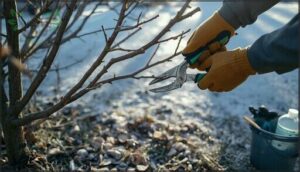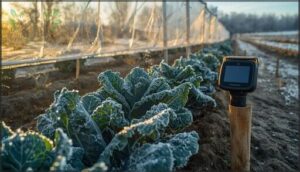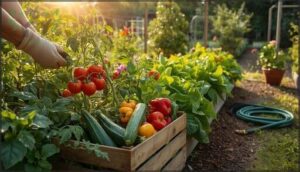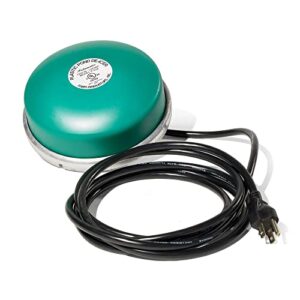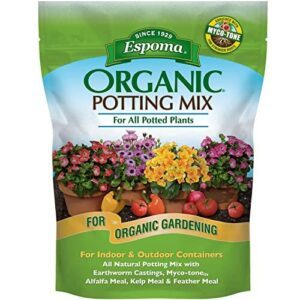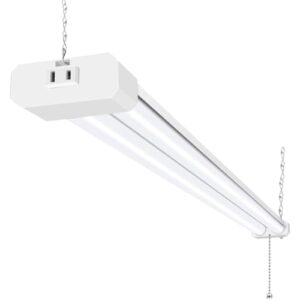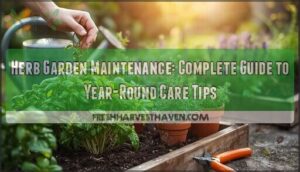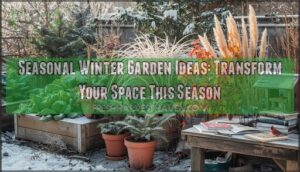This site is supported by our readers. We may earn a commission, at no cost to you, if you purchase through links.
Your garden doesn’t take vacations, and neither should your care routine. While many gardeners focus their energy on the spring planting rush, each season brings its own critical tasks that determine whether you’ll harvest abundance or disappointment.
Miss your fall perennial divisions, and you’ll watch those clumps decline. Skip winter pruning on your fruit trees, and you’re sacrificing next year’s crop before the season even starts.
The rhythm of successful gardening isn’t about working harder during peak season—it’s about knowing exactly what needs attention as the calendar turns, from indoor seed starting in January’s cold to protecting your late-season crops from surprise frosts in October.
Table Of Contents
Key Takeaways
- Successful gardening requires year-round attention to season-specific tasks rather than focusing only on spring planting, as fall divisions and winter pruning directly determine next season’s productivity.
- Spring demands precise timing for seed starting (6-8 weeks before last frost), dormant pruning (late November through early March), and perennial division (March through May) to maximize plant health and yields.
- Summer maintenance centers on strategic watering (1-2 inches weekly), mulching to retain 81% more soil moisture, and twice-weekly pest monitoring that reduces damage by up to 40%.
- Fall and winter preparation—including cover crop planting by October, dormant oil application above 40°F, and indoor seed starting 6-10 weeks before spring—sets the foundation for the entire growing cycle.
Essential Spring Gardening Tasks
Spring is when your garden wakes up, and you’ve got a narrow window to set the stage for the whole growing season. The tasks you tackle now—from starting seeds indoors to protecting tender plants from late frosts—determine how productive your beds will be come summer.
Spring gives you a narrow window to set the stage for your garden’s entire growing season
Here’s what you need to focus on as the soil warms up and daylight stretches longer.
Early Spring Planting and Seed Starting
As temperatures climb in early spring, you’ll want to start seeds indoors about 6-8 weeks before your last frost date. Focus on cool-season crops like lettuce, kale, and broccoli that germinate well at 65°F.
Prepare outdoor beds by working in compost, then direct-sow peas and radishes when soil reaches 45°F. Harden off seedlings gradually, and keep frost protection handy for unexpected cold snaps.
Checking the weather forecasts beforehand is key for cold-sensitive crops.
Pruning Dormant Trees and Shrubs
Once you’ve got seedlings on the way, turn your attention to pruning dormant trees and shrubs between late November and early March. This timing gives you better visibility of branch structure and helps wounds heal before spring growth kicks in. Dormant pruning improves plant structure and health.
- Remove dead, damaged, or diseased branches to boost plant health and reduce fungal issues
- Keep cuts under 5 cm diameter and sanitize tools between plants to prevent disease spread
- Limit removal to 25% of limbs per session to minimize stress on the plant
Dividing and Transplanting Perennials
After pruning wraps up, March through May offers ideal conditions for dividing and transplanting perennials. Most summer-flowering types thrive when split during this window, while spring bloomers like iris prefer summer division after flowering.
Use a sharp spade to separate clumps into sections with 3-5 shoots each, replant immediately, and keep divisions shaded and moist during establishment. This plant propagation technique rejuvenates aging plants, improves airflow, and boosts drought resilience by 30%. Proper post-transplant care ensures over 80% survival rates while maintaining structured garden layouts season after season.
| Timing | Best Candidates | Division Benefits |
|---|---|---|
| Spring (March–May) | Summer-flowering perennials | 50% bloom increase, reduced disease |
| Summer (June–August) | Spring-flowering perennials | Post-bloom root development |
| Autumn (September–November) | Most hardy perennials | Enhanced moisture availability |
| Every 3–5 years | Overcrowded clumps | Prevents 40–60% flower reduction |
Applying Mulch and Soil Amendments
Once divisions are in place, late March to early May is your prime opportunity for applying mulch and soil amendments. Layer organic matter 2–4 inches deep to cut water loss by up to 70% and suppress 90% of weeds. Compost and bio-based products improve nutrient availability, while shredded hardwood delivers excellent erosion control and weed suppression compared to straw.
Top soil improvement techniques for spring:
- Mulch water retention – Spread wood chips or bark to lock in moisture and reduce irrigation frequency by 50%
- Seasonal mulch application – Purchase bags in late March for the best pricing, usually $2–$3 per 2-cubic-foot bag
- Environmental mulch impact – Choose recycled wood fiber to lower greenhouse gas emissions by 25–35% versus synthetic barriers
Managing Cool-season Crops and Frost Protection
As soon as frost dates stabilize, you can push cool-season crops like spinach and kale two weeks ahead of the last freeze. Frost-resistant varieties cut yield losses by 40–60%, while physical covers and evening irrigation techniques protect tissue down to 28°F.
Monitoring systems with real-time alerts improve loss reduction by 25%, making winter protection and seasonal planting far more predictable in vegetable gardening.
Summer Garden Maintenance and Care
Summer is when your garden hits its stride, but it also demands your attention to keep everything healthy and productive. The heat, pests, and rapid growth mean you’ll need to stay on top of watering, feeding, and protecting your plants.
Here are the essential tasks that’ll help your garden thrive through the hottest months.
Watering and Irrigation Strategies
When summer heat kicks in, your watering schedule becomes critical for plant survival. You’ll need 1 to 2 inches of water weekly, adjusting for sandy soils and temperatures.
Drip irrigation cuts water use by 20-60% compared to sprinklers, delivering moisture directly to roots. Smart technology with soil moisture sensors prevents waste.
Regional needs—especially in arid zones—may require extra watering during extreme heat.
Mulching for Moisture Retention
When July and August arrive, mulch becomes your strongest ally against moisture loss. Organic amendments like shredded wood retain up to 81% more soil moisture than bare soil, reducing evaporation by 75%.
Apply mulch thickness at 2-4 inches to lower soil temperature by 8-13°F, boost water infiltration, and cut irrigation needs by 30%.
These mulching techniques directly improve crop yield and water management.
Pest and Disease Monitoring
Early pest detection saves your garden from devastating losses. With garden pest control efforts reducing damage by up to 40%, regular surveillance technology and IPM strategies protect your hard work.
Check plants twice weekly for these warning signs:
- Yellowing or spotted leaves indicating disease identification needs
- Chewed foliage from insects like aphids or beetles
- Sticky residue suggesting whitefly or aphid activity
- Wilting despite adequate moisture
- Unusual growths or discoloration
Data-driven control methods help you manage garden pests effectively before problems escalate.
Fertilizing Lawns, Vegetables, and Flowers
Your plants need the right nutrients at the right time to thrive. Soil testing helps you understand what’s missing before you fertilize.
Lawns perform best with 0.5–1 pound of nitrogen per 1,000 square feet, usually applied in May or early September.
Your vegetable garden benefits from a balanced 10-10-10 NPK ratio, while flower gardens excel with 5-10-10 during bloom. Organic options like soybean meal work well too.
Over-fertilization causes more harm than good.
Pruning Summer-flowering Shrubs
You’ll want to tackle pruning summer-flowering shrubs in early to mid-spring, before new growth kicks into gear. These plants bloom on current-season wood, so proper timing extends flowering by up to four weeks.
Use the renewal method—cutting one-third of the largest stems to the base—to boost bloom density by 35–60%. This approach also improves disease control and air circulation considerably.
Fall Preparation and Planting Guide
Fall is your garden’s change of seasons, and the work you do now sets the stage for next spring’s success. This season calls for planting hardy crops, protecting what you’ve grown, and preparing beds for their winter rest.
Here’s what you need to tackle before the first hard freeze arrives.
Planting Fall Vegetables and Cover Crops
As the fall planting timeline approaches, you’ll seed frost-tolerant varieties like broccoli and cabbage around late July—about 10 weeks before the first frost. Your fall vegetable gardens benefit from the seasonal planting of arugula and lettuce in late August.
Cover crops planted in October boost soil health while extending the harvest window for kale and spinach into winter. These cover crop benefits include improved nitrogen and reduced input costs long-term.
Dividing Perennials and Transplanting
After seeding your cover crops, it’s time to tackle perennials showing crowded centers or reduced blooms. Division timing in fall works best for summer-flowering types—dig when temps cool but allow six to eight weeks before hard frost. Each division needs three to five shoots with healthy roots for strong plant vigor. Regional adjustments matter: delay if autumn brings heavy rain to prevent rot.
- Spring division suits fall bloomers; summer division follows spring bloomers
- Root health improves when you replant promptly and keep soil moist
- Skip amendments in planting holes—native soil fosters better establishment
Pruning and Protecting Trees for Winter
Once your perennials are divided, shift focus to dormant pruning. Late fall through winter—when temperatures drop below 32°F—is ideal for most trees, including fruit tree pruning and care.
Remove dead or damaged branches first, using clean cuts above outward buds. Tree wrapping protects thin-barked saplings from sunscald, cutting mortality by 35%.
Mulch benefits include insulating roots and stabilizing soil temperatures, while monitoring trees for split bark helps you catch winter damage early.
Cleaning Garden Beds and Composting
After protecting your trees, turn to bed cleanup—one of fall’s most valuable gardening tasks. You’ll generate about 122 to 155 kg of garden waste annually, with fall producing the bulk.
Chop woody debris into ½- to 1.5-inch pieces for faster composting benefits. Mix 25% compost into your top 6-8 inches of soil for soil enrichment, raising organic carbon by nearly 3% while cutting cleanup costs through DIY seasonal timing.
Seed Saving and Garden Planning for Next Year
Before the ground hardens, harvest seeds from self-pollinating crops like beans and tomatoes—choosing healthy parent plants locks in trait selection for future years. Test seed viability by storing samples at 5°C and checking germination rates above 70%.
Update garden records with crop rotation details, planting dates, and yields. Digital tools help you map a three-year rotation plan, keeping your vegetable garden planning sharp for spring.
Winter Gardening Activities and Planning
Winter might seem like downtime in the garden, but it’s actually the perfect season to plan, prepare, and tackle a few essential tasks that set you up for success come spring. From starting seeds indoors to pruning dormant fruit trees, there’s plenty you can do even when the ground is frozen.
Here are the key winter activities that’ll keep your garden thriving year-round.
Indoor Seed Starting and Grow Light Setup
Starting seeds indoors gives you a jump on the season and cuts costs. Begin six to ten weeks before your last frost, using grow lights with high LED efficacy for faster growth.
Maintain germination temperatures between 65–75°F and humidity at 50–70%. Tomatoes prefer 70–85°F, while lettuce thrives at 60–70°F.
Follow seedling schedules on seed packets to time transplants perfectly for growers ready to dig in.
Ordering Seeds and Supplies
While seed catalog trends shift, ordering early beats supply chain impacts and secures better cultivars. Browse vegetable seeds by December for the best organic seed sourcing options—hobby gardeners spent USD 671 on average in 2024, so budgeting seeds wisely matters.
Store packets in cool, dark spots with proper seed storage methods. Planning these gardening tasks now ensures seasonal gardening success when seed starting begins.
Protecting Overwintering Plants and Ponds
Winter protection separates thriving gardens from losses—container protection and plant insulation make all the difference. Here’s your risk reduction checklist for overwintering container plants and pond winterization:
- Wrap pots with mulch or straw to maintain higher soil temperatures
- Group containers together, water before freezing
- Install pond heaters to keep surfaces partially ice-free
- Monitor water temperature at multiple depths
- Apply anti-desiccant sprays to exposed evergreens
Dome covers prevent snow damage while supporting healthy pond life through spring.
Pruning Fruit Trees and Applying Dormant Oil
Late winter pruning sets up your fruit trees for healthier, more productive seasons ahead. You’ll want to prune between late January and early March, before buds swell, removing no more than 25% of the wood to avoid excessive water sprouts. Combine this with dormant oil application at 2–4% concentration when temperatures stay above 40°F for 24 hours.
This approach handles growth regulation while controlling overwintering pests effectively.
| Task | Timing |
|---|---|
| Dormant pruning for structural health | Late January–Early March |
| Apply dormant oil for pest management | Above 40°F, 24 hours |
| Target pests (aphids, mites, scale) | Before bud swell |
Reviewing and Updating Garden Plans
Before spring’s rush begins, you need to review last year’s garden planning and maintenance notes. Research shows updated seasonal gardening plans boost plant survival by 22% and cut material waste by 28%.
Use planning software to map spaces, schedule soil testing, and set SMART goals for seasonal adaptation. This simple step delivers financial savings averaging $500 annually while extending your gardening schedule by 12 days.
Top 4 Products for Seasonal Gardening Success
The right tools make seasonal gardening easier, whether you’re starting seeds indoors or protecting plants through winter. You don’t need a garage full of equipment, just a few reliable products that work when you need them.
Here are four essentials that’ll help you tackle tasks year-round without breaking the bank.
1. Farm Innovators Pond De Icer Heater
You’ll want to keep your pond inhabitants safe through winter, and that’s where a reliable de-icer makes all the difference. The Farm Innovators model delivers 1,250 watts of thermostatically controlled heating, maintaining an ice-free opening for gas exchange in ponds ranging from 50 to 600 gallons.
Cast aluminum construction ensures efficient energy consumption while protecting fish and aquatic plants.
It’s essential pond maintenance that aids your broader wildlife gardening efforts, working alongside your bird feeders and other winter protection strategies to create a thriving backyard ecosystem.
Best For: Pond owners in cold climates who need to maintain a safe ice-free area for fish and aquatic life during winter months.
- Thermostatically controlled operation saves energy by running only when needed, reducing electricity costs by up to 30%
- Cast aluminum construction provides superior heat transfer and durability compared to plastic models
- Simple floating design requires no tools or special installation—just place it in your pond and plug it in
- Durability issues reported by some users, with units sometimes failing after 1-3 seasons
- Aluminum housing may corrode after the first year of use
- Return shipping costs aren’t covered under the warranty, which can be frustrating if you need a replacement
2. Espoma Organic Potting Soil Mix
Once you’ve secured your pond for the season, it’s time to prep your containers for year-round planting. Espoma Organic Potting Soil Mix brings organic certification to your container gardening efforts, blending sphagnum peat moss, perlite, and humus for enhanced water retention.
The real magic lies in its mycorrhizae benefits—over 3 million fungal propagules per cubic foot create root partnerships that boost nutrient uptake. This soil composition works across all seasons, whether you’re starting seeds indoors or maintaining houseplants.
It supports your ongoing garden maintenance with natural amendments like earthworm castings and kelp meal.
Best For: Organic gardeners who want a ready-to-use potting mix with mycorrhizal fungi for healthier root development in containers, herbs, and vegetables.
- Contains over 3 million mycorrhizal fungal propagules per cubic foot that form partnerships with roots to improve nutrient and water uptake
- Certified for organic gardening with natural ingredients like earthworm castings, kelp meal, and feather meal instead of synthetic fertilizers
- Balanced blend of peat moss, perlite, and humus creates good drainage while retaining moisture for container plants
- Not sterilized, so you might find small twigs, wood pieces, or occasionally bugs and mushrooms in the bag
- Quality can be inconsistent depending on how it’s been stored before you buy it
- May not be ideal for starting delicate seedlings since it’s not heat-treated to remove potential pathogens
3. Barrina LED T5 Shop Lights
When indoor seed starting heats up in January and February, you’ll need reliable light spectrum support. The Barrina LED T5 shop lights deliver 2,200 lumens at just 20W, offering great energy efficiency for your houseplants and forcing bulbs indoors.
The 6,500K cool-white option aids vegetative plant growth during winter months, while the linkable design—connecting up to eight fixtures—gives you flexible installation options across seed-starting racks.
Product reliability varies in cold basements, though the three-year warranty covers early failures as you work toward encouraging holiday cactus bloom.
Best For: Budget-conscious gardeners who need efficient, linkable lighting for seed starting racks and indoor plant propagation during winter months.
- High energy efficiency at 2,200 lumens for only 20W, keeping electricity costs low during extended winter growing periods
- Linkable design connects up to eight fixtures on one power feed, making multi-shelf installations simple without needing multiple outlets
- 6,500K cool-white spectrum supports vegetative growth and seedling development at a fraction of the cost of dedicated grow lights
- Reliability issues reported in cold environments like unheated basements, with some users experiencing failures within the first year
- Not compatible with motion sensors, which limits automation options and can shorten lifespan if used with them anyway
- Moderate CRI of 85 means color accuracy isn’t as good as higher-end options, though it’s adequate for general plant care
4. Hykolity Linkable LED Shop Light
When your seed racks need more power than T5s can deliver, the Hykolity Linkable LED Shop Light pumps out 4,400 lumens using just 42W—installation options include both hanging and flush-mount setups. You’ll link up to four units together for lighting versatility across your entire workspace, and the 5000K daylight spectrum works beautifully for year-round seasonal gardening tasks.
Customer satisfaction runs high after 2.5 years of use, with long-term reliability backed by ETL certification and energy efficiency that cuts costs by 75%.
Best For: Gardeners and workshop users who need bright, energy-efficient lighting for seed starting areas, workbenches, or larger spaces where you can link multiple fixtures together.
- Delivers impressive 4,400 lumens at 5000K daylight spectrum while using only 42W, cutting energy costs by up to 75% compared to old fluorescent fixtures
- Link up to four units together with plug-and-play setup—only the first light needs an outlet, making multi-fixture installations super simple
- Proven long-term reliability with 50,000-hour lifespan and no bulb replacements needed, plus responsive customer service if issues come up
- Power cord runs short for some setups at 59 inches, and the pull chain might not reach comfortably depending on your mounting height
- Comes with a plug rather than hardwire option, which limits installation flexibility if you prefer direct electrical connection
- Some users report occasional quality control hiccups like bent shields arriving in the box
Frequently Asked Questions (FAQs)
How do I prepare garden soil in early spring?
Test your soil pH and add compost to improve structure. Work beds when moist but not waterlogged, then apply mulch to retain moisture and suppress weeds as temperatures rise.
What vegetables can I grow in containers year-round?
You can grow leafy greens like lettuce and spinach, root vegetables such as radishes and short carrots, cherry tomatoes, peppers, bush beans, and fresh herbs year-round in containers indoors or outdoors.
How often should I test my soil pH?
You’re probably overthinking it—established garden beds only need pH testing every three to five years. Sandy soil or heavy amendments? Check annually. Clay soils tolerate longer gaps between tests.
When should I rotate crops to prevent disease?
Plan a three to four-year rotation cycle for your vegetable garden. This interval reduces soil-borne disease pressure by up to 52%, interrupts pathogen lifespan, and cuts pesticide costs by roughly 28%.
What are the best companion planting combinations?
Pair tomatoes with basil for pest reduction and better yields, beans with corn for nitrogen fixation, and nasturtiums near squash to attract beneficial insects.
These combinations support soil health, pollinator attraction, and organic gardening success.
Conclusion
The gardener who plants with the seasons reaps rewards all year long. That’s the truth behind mastering gardening tasks by season—each month offers opportunities you can’t afford to miss.
Your January pruning shapes summer’s harvest, while October’s mulch protects spring’s blooms. Start small if you need to, but commit to the calendar. Your garden will respond to consistent attention across all twelve months, not just the sunny ones everyone remembers.
- https://journeywithjill.net/gardening/2024/04/25/spring-gardening-checklist-for-beginners/
- https://alslandscaping.co.uk/a-guide-for-seasonal-garden-maintenance/
- https://www.daintydressdiaries.com/2023/07/seasonal-gardening-calendar-what-to-plant-and-do-each-month.html
- https://www.youtube.com/watch?v=nQs45NimCOU
- https://gardenbetty.com/a-fall-garden-checklist-for-maximizing-the-season-and-winterizing-your-yard/



